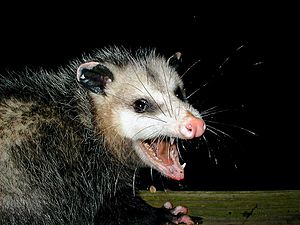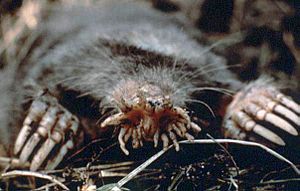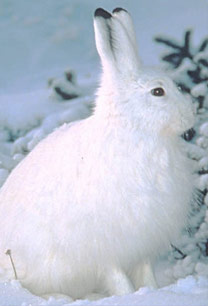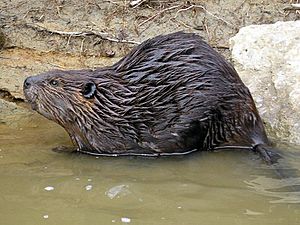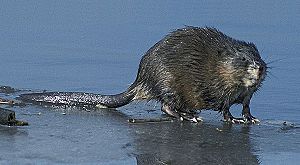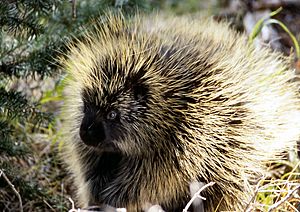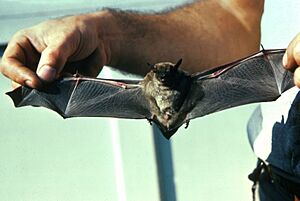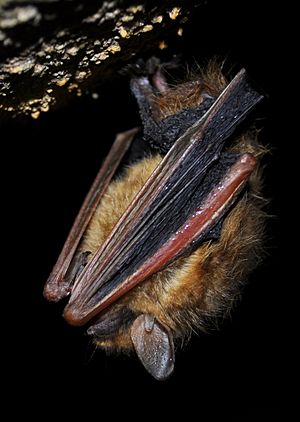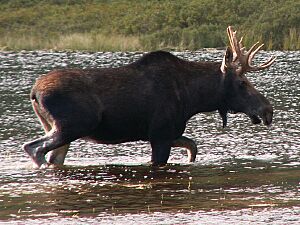List of mammals of New York facts for kids
This article lists the amazing mammals that live in the state of New York. From tiny mice to huge whales, New York is home to many different kinds of furry creatures! Some of these animals have always lived here, while others were brought here by people. Sadly, some animals that used to live in New York are no longer found here.
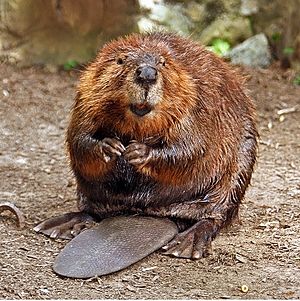
Scientists and conservation groups like the International Union for Conservation of Nature (IUCN) keep track of how many animals are left in the wild. This helps us understand which animals might be in danger. Here's what some of their special tags mean:
| Extinct | This means the animal is completely gone. The last one has died. | |
| Extinct in the wild | These animals only live in zoos or special protected areas, not in their natural homes. | |
| Critically endangered | These animals are in extreme danger of disappearing forever from the wild. | |
| Endangered | These animals face a very high risk of disappearing from the wild. | |
| Vulnerable | These animals are at a high risk of becoming endangered in the future. | |
| Near threatened | These animals are not currently at high risk, but they might be in danger soon. | |
| Least concern | There are no big worries about these animals right now. | |
| Data deficient | We don't have enough information to know if these animals are in danger or not. |
Contents
Opossums: The Only Marsupial in New York
Opossums are unique mammals. They are the only marsupials (animals that carry their babies in a pouch) found in North America. The Virginia opossum is the only type of opossum you'll find in New York.
- Family Didelphidae (American opossums)
- Subfamily: Didelphinae
- Genus: Didelphis
- Virginia opossum, D. virginiana
- Genus: Didelphis
- Subfamily: Didelphinae
Insectivores: Shrews and Moles
These small mammals love to eat insects! Shrews look a lot like mice, but they have longer snouts and tiny eyes. Moles are amazing diggers with strong bodies, perfect for tunneling underground.
- Family Soricidae (shrews)
- Genus: Blarina
- Northern short-tailed shrew B. brevicauda
- Genus: Cryptotis
- North American least shrew C. parva
- Genus: Sorex
- Masked shrew S. cinereus
- Long-tailed shrew S. dispar
- Smoky shrew S. fumeus
- American pygmy shrew S. hoyi
- American water shrew S. palustris
- Genus: Blarina
- Family Talpidae (moles)
- Genus: Condylura
- Star-nosed mole, C. cristata
- Genus: Parascalops
- Hairy-tailed mole, P. breweri
- Genus: Scalopus
- Eastern mole, S. aquaticus
- Genus: Condylura
Lagomorphs: Hares and Rabbits
Lagomorphs might look like rodents, but they are a separate group of mammals. One key difference is that they have four front teeth in their upper jaw, while rodents only have two.
- Family Leporidae (rabbits and hares)
- Genus: Lepus
- Snowshoe hare, L. americanus
- European hare, L. europaeus (This animal was brought to New York by people.)
- Genus: Sylvilagus
- Eastern cottontail, S. floridanus
- New England cottontail, S. transitionalis
- Genus: Lepus
Rodents: The Largest Mammal Group
Rodents make up the biggest group of mammals on Earth! More than 40% of all mammal species are rodents. They have special front teeth that never stop growing, so they have to keep gnawing on things to keep them short.
- Family Castoridae (beavers)
- Genus: Castor
- North American beaver, C. canadensis
- Genus: Castor
- Family Cricetidae (New World mice, rats, voles, lemmings, muskrats)
- Genus: Microtus
- Rock vole, M. chrotorrhinus
- Meadow vole, M. pennsylvanicus
- Gull Island vole, M. p. nesophilus
- Woodland vole, M. pinetorum
- Genus: Clethrionomys
- Southern red-backed vole, C. gapperi
- Genus: Neotoma
- Allegheny woodrat, N. magister (This animal used to live in New York but is no longer found here.)
- Genus: Ondatra
- Muskrat, O. zibethicus
- Genus: Peromyscus
- White-footed mouse, P. leucopus
- Eastern deermouse, P. maniculatus
- Genus: Synaptomys
- Northern bog lemming, S. borealis
- Southern bog lemming, S. cooperi
- Genus: Microtus
- Family Dipodidae (jumping mice)
- Genus: Napaeozapus
- Woodland jumping mouse, N. insignis
- Genus: Zapus
- Meadow jumping mouse, Z. hudsonius
- Genus: Napaeozapus
- Family Erethizontidae (New World porcupines)
- Genus: Erethizon
- North American porcupine, E. dorsatum
- Genus: Erethizon
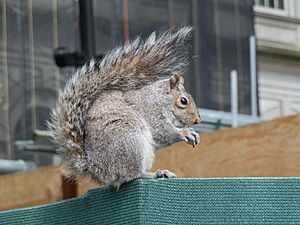
- Family Muridae (Old World mice and rats)
- Genus: Mus
- House mouse, M. musculus (This animal was brought to New York by people.)
- Genus: Rattus
- Norway rat, R. norvegicus (This animal was brought to New York by people.)
- Black rat, R. rattus (This animal was brought to New York by people.)
- Genus: Mus
- Family Sciuridae (squirrels)
- Genus: Glaucomys
- Northern flying squirrel, G. sabrinus
- Southern flying squirrel, G. volans
- Genus: Marmota
- Groundhog, M. monax
- Genus: Sciurus
- Eastern gray squirrel, S. carolinensis
- Fox squirrel, S. niger
- Genus: Tamias
- Eastern chipmunk, T. striatus
- Genus: Tamiasciurus
- American red squirrel, T. hudsonicus
- Genus: Glaucomys
Bats: Mammals That Can Fly!
Bats are truly special because they are the only mammals that can actually fly! Their front limbs have developed into wings. About one-fifth of all mammal species are bats.
- Family Vespertilionidae (vesper bats)
- Genus: Aeorestes
- Hoary bat, A. cinereus
- Genus: Eptesicus
- Big brown bat, E. fuscus
- Genus: Lasionycteris
- Silver-haired bat, L. noctivagans
- Genus: Lasiurus
- Eastern red bat, L. borealis
- Seminole bat, L. seminolus
- Genus: Myotis
- Eastern small-footed bat, M. leibii
- Little brown bat, M. lucifugus
- Northern long-eared bat, M. septentrionalis
- Indiana bat, M. sodalis
- Genus: Perimyotis
- Tricolored bat, P. subflavus
- Genus: Aeorestes
Carnivores: Meat-Eating Mammals
Carnivores are mammals that mostly eat meat. They have special teeth and skull shapes that help them hunt and eat their prey. There are over 260 different kinds of carnivores!
- Family Canidae (dogs, wolves, foxes)
- Genus: Canis
- Coyote, C. latrans
- Eastern coyote, C. l. ssp.
- Eastern wolf, C. lycaon (This animal used to live in New York but is no longer found here.)
- Red wolf, C. rufus (This animal used to live in New York but is no longer found here.)
- Coyote, C. latrans
- Genus: Urocyon
- Gray fox, U. cinereoargenteus
- Genus: Vulpes
- Red fox, V. vulpes
- Genus: Canis
- Family Procyonidae (raccoons)
- Genus: Procyon
- Common raccoon, P. lotor
- Genus: Procyon
- Family Ursidae (bears)
- Genus: Ursus
- American black bear, U. americanus
- Genus: Ursus
- Family Felidae (cats)
- Genus: Lynx
- Canada lynx, L. canadensis (This animal used to live in New York but is no longer found here.)
- Bobcat, L. rufus
- Genus: Puma
- Cougar, P. concolor (This animal used to live in New York but is no longer found here.)
- Genus: Lynx
- Family Mustelidae (weasels, minks, martens, fishers, and otters)
- Genus: Gulo
- Wolverine, G. gulo (This animal used to live in New York but is no longer found here.)
- Genus: Lontra
- North American river otter, L. canadensis
- Genus: Martes
- American marten, M. americana
- Genus: Mustela
- Least weasel, M. nivalis
- American ermine, M. richardsonii
- Genus: Neogale
- Long-tailed weasel, N. frenata
- American mink, N. vison
- Genus: Pekania
- Fisher, P. pennanti
- Genus: Taxidea
- American badger, T. taxus
- Genus: Gulo
- Family Mephitidae (skunks)
- Genus: Mephitis
- Striped skunk, M. mephitis
- Genus: Mephitis
- Family Phocidae (seals)
- Genus: Halichoerus
- Gray seal, H. grypus
- Genus: Pagophilus
- Harp seal, P. groenlandicus
- Genus: Phoca
- Harbor seal, P. vitulina
- Genus: Pusa
- Ringed seal, P. hispida
- Genus: Halichoerus
Even-Toed Ungulates: Hoofed Mammals
Even-toed ungulates are hoofed animals that walk mostly on their third and fourth toes. This group includes animals like deer, moose, and bison.
- Family Cervidae (deer)
- Genus: Alces
- Moose, A. alces
- Eastern moose, A. a. americana
- Moose, A. alces
- Genus: Cervus
- Elk, C. canadensis (This animal used to live in New York but is no longer found here.)
- Eastern elk, C. c. canadensis
- Sika deer, C. nippon (This animal was brought to New York by people.)
- Elk, C. canadensis (This animal used to live in New York but is no longer found here.)
- Genus: Odocoileus
- White-tailed deer, O. virginianus
- Genus: Alces
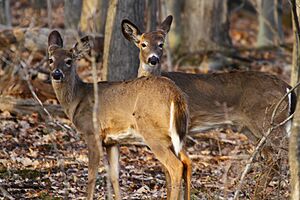
-
- Genus: Rangifer
- Caribou R. tarandus (This animal used to live in New York but is no longer found here.)
- Boreal woodland caribou R. t. caribou (This animal used to live in New York but is no longer found here.)
- Caribou R. tarandus (This animal used to live in New York but is no longer found here.)
- Genus: Rangifer
- Family Bovidae (bison)
- Genus: Bison
- American bison, B. bison (This animal used to live in New York but is no longer found here.)
- Genus: Bison
- Family Suidae (pigs)
Cetaceans: Mammals of the Ocean
Cetaceans are mammals that live entirely in the water. They have sleek, mostly hairless bodies and a thick layer of blubber to keep them warm. Their front limbs and tails are shaped like fins to help them swim. This group includes whales and dolphins.
- Family Balaenidae (right whales)
- Genus: Balaena
- Bowhead whale, B. mysticetus
- Genus: Eubalaena
- North Atlantic right whale, E. glacialis
- Genus: Balaena
- Family Balaenopteridae (rorquals)
- Genus: Balaenoptera
- Common minke whale, B. acutorostrata
- Sei whale, B. borealis
- Blue whale, B. musculus
- Fin whale, B. physalus
- Genus: Megaptera
- Humpback whale, M. novaeangliae
- Genus: Balaenoptera
- Family Kogiidae (false sperm whales)
- Genus: Kogia
- Pygmy sperm whale, K. breviceps
- Dwarf sperm whale, K. sima
- Genus: Kogia
- Family Physeteridae (sperm whales)
- Genus: Physeter
- Sperm whale, P. macrocephalus
- Genus: Physeter
- Family Ziphiidae (beaked whales)
- Genus: Hyperoodon
- Northern bottlenose whale, H. ampullatus
- Genus: Mesoplodon
- Sowerby's beaked whale, M. bidens
- Blainville's beaked whale, M. densirostris
- Gervais' beaked whale, M. europaeus
- True's beaked whale, M. mirus
- Genus: Ziphius
- Cuvier's beaked whale, Z. cavirostris
- Genus: Hyperoodon
- Family Monodontinae (narwhal and beluga)
- Genus: Delphinapterus
- Beluga whale, D. leucas (This whale is usually found elsewhere but sometimes visits New York's waters.)
- Genus: Delphinapterus
- Family Delphinidae (dolphins)
- Genus: Delphinus
- Short-beaked common dolphin, D. delphis
- Genus: Globicephala
- Short-finned pilot whale, G. macrorhynchus
- Long-finned pilot whale, G. melas
- Genus: Grampus
- Risso's dolphin, G. griseus
- Genus: Lagenorhynchus
- Atlantic white-sided dolphin, L. acutus
- Genus: Orcinus
- Orca, O. orca
- Genus: Stenella
- Clymene dolphin, S. clymene
- Striped dolphin, S. coeruleoalba
- Atlantic spotted dolphin, S. frontalis
- Spinner dolphin, S. longirostris
- Genus: Tursiops
- Common bottlenose dolphin, T. truncatus
- Genus: Delphinus
- Family Phocoenidae (porpoises)
- Genus: Phocoena
- Harbor porpoise, P. phocoena
- Genus: Phocoena
More About New York Animals
- Seneca white deer
- Rats in New York City


